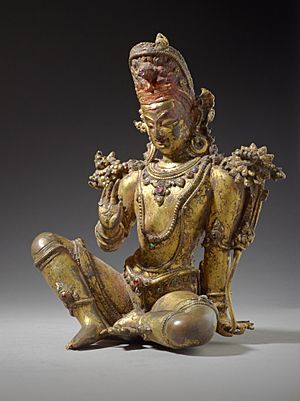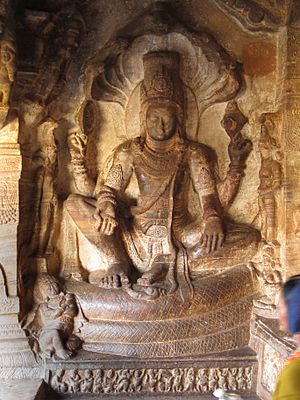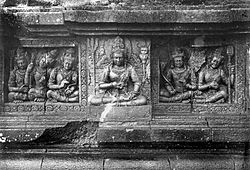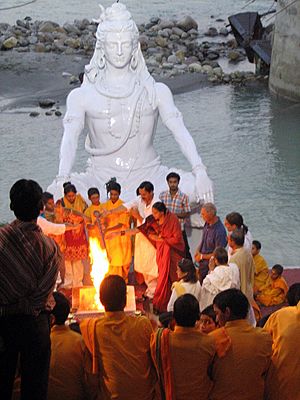Deva (Hinduism) facts for kids

Quick facts for kids Translations ofDeva |
|
|---|---|
| English | Heavenly, divine, shiny, exalted, anything of excellence, donor of knowledge or resources. |
| Sanskrit | देव (IAST: deva) |
| Assamese | দেৱতা (dewatā) |
| Balinese | ᬤᬾᬯ (déwa) |
| Bengali | দেবতা (debota) |
| Hindi | देवता (devatā) |
| Javanese | ꦢꦺᬯ (déwa) |
| Kannada | ದೇವ (deva) |
| Malayalam | ദേവൻ (devan) |
| Marathi | देव (dev) |
| Nepali | देवता (devatā) |
| Odia | ଦେବତା (debôta) |
| Tamil | தேவர்கள் (tevarkal̤) |
| Telugu | దేవుడు (dēvuḍu) |
| Glossary of Hinduism terms | |
Deva is a Sanskrit word that means "shiny," "heavenly," or "divine being." It is used in Hinduism to describe a deity or god. The word Deva is masculine. Its feminine (female) form is Devi.
In the oldest Hindu texts, called the Vedas, all supernatural beings were known as Devas and Asuras. Over time, the meaning changed. By the late Vedic period, Devas usually meant good, helpful supernatural beings.
In later Hindu texts, like the Puranas, Devas represent good forces. Asuras represent bad or negative forces. Sometimes, Devas are also called Suras and are seen as the opposite of their powerful but evil half-brothers, the Asuras.
Devas are an important part of Indian mythology. They appear in many stories and ideas about how the universe works in Hinduism. They are often found alongside Asuras, Yakshas (nature spirits), and Rakshasas (ghoulish ogres or demons).
Contents
What Does the Word Deva Mean?
The word Deva comes from Sanskrit, an ancient Indian language. It appeared in texts from about 2000 BCE. Sir Monier Monier-Williams, a famous scholar, translated it as "heavenly, divine, shining ones." It also refers to a god or deity.
The Sanskrit word deva- comes from an even older word, *daiv-, which means "celestial" or "shining." This root word is connected to many other words in different languages. For example, it's related to the Greek word "Zeus," the Roman word "Deus" (meaning "god"), and the English words "divine" and "deity."
The feminine form, devi, means "female deity." When capitalized, Devi or Mata refers to a divine mother goddess in Hinduism. Deva can also be called Devatā, and Devi can be called Devika.
Sometimes, Deva is used as part of a name in Indian culture. It means someone who wants to be excellent or a "master of" something.
Devas in Ancient Hindu Texts
The oldest parts of the Vedas, called the Samhitas, list 33 Devas. These are often grouped as 11 for each of the three worlds (earth, atmosphere, sky). Or, they are seen as 12 Adityas, 11 Rudras, 8 Vasus, and 2 Asvins.
Some Devas represent parts of nature, like Agni (fire) or Vayu (wind). Others represent good values, like Varuna and Mitra. Each Deva shows a special kind of knowledge, creative power, or amazing abilities.
The most important Devas in the Rig Veda are Indra, Agni (fire), and Soma. Agni is seen as a friend to all people. Agni and Soma are often honored in a special fire ritual called a yajna. Other important Devas include Savitr, Vishnu, Rudra (later known as Shiva), and Prajapati (later known as Brahma).
Important Devas and Their Roles
Here are some of the well-known Devas and what they are known for:
- Brahma: The god of creation.
- Vishnu: The god who preserves and protects the universe.
- Shiva: The god of destruction and time; also linked to new life.
- Ganesha: The god of new beginnings, wisdom, and good luck.
- Hanuman: A god known for courage, respect, and strength.
- Indra: The king of the gods and the god of weather, storms, and the sky.
- Agni: The god of fire.
- Vayu: The god of air, wind, and breath.
- Varuna: The god of water and rain.
- Surya: The god of the sun, light, and day.
- Chandra: The god of the moon and night.
- Yama: The god of death and justice.
- Kubera: The god of wealth.
- Kamadeva: The god of love.
Understanding Many Gods (Henotheism)
In the Vedas, Deva does not mean there is only one God. Instead, it refers to a "supernatural, divine" idea that shows up in different ways. Each Deva has excellent qualities but also faces challenges. They are heroic but also have feelings and desires.
Max Muller, a scholar, noticed that Vedic hymns often call each Deva "the only one, the supreme." He explained that this is not polytheism (worshiping many gods) or monotheism (worshiping one God). Instead, it is henotheism. This means that different gods are seen as different ways to understand the same supreme truth. They are different views of respect and spirituality, all connected by principles like Ṛta (cosmic order) and Dharma (right conduct).
What Devas Are Like in Vedic Stories
Ananda Coomaraswamy, another scholar, said that Devas and Asuras in Vedic stories are like the Olympian gods and Titans in Greek myths. Both are powerful. But Devas represent light and good, while Asuras represent darkness and evil.
Coomaraswamy believed that these two sides exist within every person. The good and bad parts of us struggle when we make choices. The Hindu idea of Devas and Asuras shows this constant struggle inside each person.
In the oldest Vedic texts, both good and evil powerful beings were called Devas and Asuras. A famous hymn says Devav asura (Asuras who became Devas). It contrasts them with Asura adevah (Asuras who are not Devas). They all came from the same father, Prajapati. They lived in the same place and shared food. They all had special powers. The only difference was their intentions, actions, and choices.
Devas in the Upanishads

The ancient Upanishads also talk about Devas and their struggles with Asuras. For example, the Kaushitaki Upanishad says that Indra was weaker than the Asuras until he understood his own Atman (soul or self). Once he had self-knowledge, he became strong and won. The Upanishad says that people who know their inner self also become strong and are not harmed by evil.
The Chandogya Upanishad describes a battle between Devas and Asuras over our senses. This fight between good and evil shows up in what we see, hear, smell, and feel. It also shows up in our thoughts. The Upanishad says that the Deva-Asura battle finally reaches the soul. Here, the Asuras fail and the Devas win. This is because the soul is peaceful and naturally good.
The Brihadaranyaka Upanishad tells a story where Devas, humans, and Asuras are all sons of Prajapati. Each group asks for a lesson on how to live. Prajapati tells the Devas to practice self-control. He tells humans to practice charity (giving). He tells Asuras to practice compassion (kindness). The Upanishad says these three virtues should always be followed by everyone.
Many scholars say that the stories of Devas and Asuras in the Upanishads are symbolic. They represent the good and evil parts that live and struggle within each human being. For example, Adi Shankara, a famous scholar, said that Devas represent our desire for spiritual things. Asuras represent our desire for too much worldly stuff. This symbolism reminds us that we must work hard to understand ideas. Learning is a process, and our "Deva nature" comes out with effort.
Devas in the Puranas and Epics
In the Puranas and the Itihasas (like the Bhagavad Gita), Devas usually represent good, and Asuras represent bad. The Bhagavad Gita says that all beings have both divine (god-like) and demonic (evil-like) qualities inside them. It also says that truly god-like or truly demon-like people are rare. Most people have a mix of good and bad traits.
In Hindu stories, everyone starts as an Asura, born from the same father. "Asuras who stay Asura" are powerful beings who want more power, wealth, and are full of ego, anger, and violence. "Asuras who become Devas" are guided by an inner voice. They seek understanding, prefer balance, good behavior, morals, knowledge, and peace.
The fights between Devas and Asuras are the source of many famous stories in Hindu literature. These stories are often told without judging who is right or wrong. Some of these tales are the basis for major Hindu festivals. For example, the story of the Asura Ravana and the Deva Rama is told in the Ramayana. The legend of the Asura Hiranyakashipu and the Deva Vishnu (as Narasimha) is celebrated during the spring festival of Holi.
Symbolic Meanings
Scholars like Edelmann say that the differences between Devas and Asuras in the Puranas are symbols for spiritual ideas. For example, the god Indra (a Deva) and the anti-god Virocana (an Asura) both ask a wise man for knowledge about the self. Virocana quickly accepts the first answer. He thinks he can use this knowledge as a weapon. But Indra keeps asking questions. He digs deeper and learns about inner happiness and power. This shows that you must work hard with ideas. Your "Deva nature" comes out with effort.
The god (Deva) and anti-god (Asura) also symbolize the opposing forces that motivate each person. So, the Deva-Asura difference is a spiritual idea, not just about family or species. In the Bhāgavata Purana, saints and gods are born into Asura families, like Mahabali and Prahlada. This shows that your actions, beliefs, and motivations define whether you are Deva-like or Asura-like, not your birth or family.
Devas in Modern Hinduism

In Hinduism, Devas are heavenly beings linked to different parts of the universe. Important Devas like Brahma, Vishnu, and Shiva form the Hindu trinity. They oversee how the universe works and how creation develops.
Lesser Devas might control natural forces. Examples include Vayu, the god of wind, Varuna, the god of water, and Agni, the god of fire.
Hinduism also has other heavenly beings. These include the Gandharvas (male celestial musicians) and Apsaras (female celestial dancers).
Devas in Sangam Literature
Sangam literature from Tamil (300 BCE-300 CE) also mentions offerings made to Devas. The ancient Tamil epic Silapathikaram describes offerings for four types of Devas.
See also
 In Spanish: Deva (religión) para niños
In Spanish: Deva (religión) para niños
- Vishvadevas
- Ishvara
- Bhagavan
- God and gender in Hinduism
- Hindu deities
- Deva (Buddhism)
- Jangam
- Divinity
- Devata
- Daeva
- Diwata



